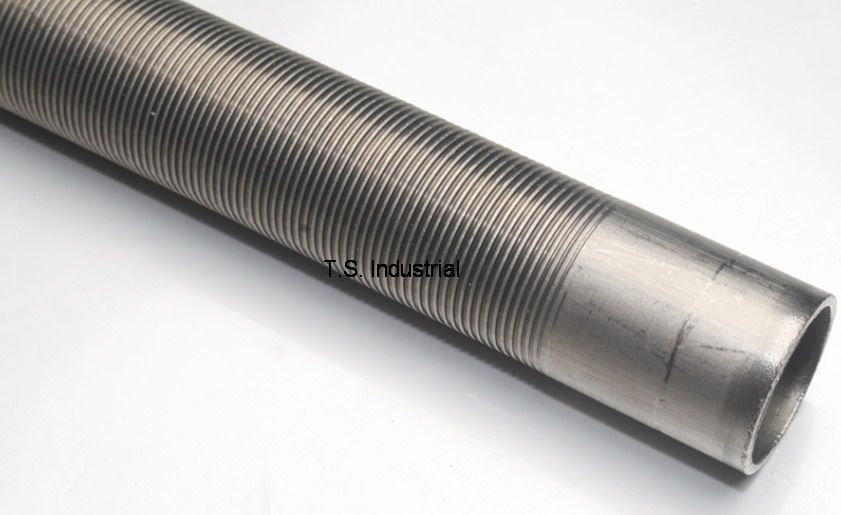What are NEOTIS HPT Finned Tubes?
2025-01-04Leave a message
What are NEOTIS HPT Finned Tubes?
HPT stands for High Performance Tube. HPT = High Performance Tube. This designation indicates that the finned tubes are specifically designed for high-performance heat transfer applications, where both efficiency and reliability are paramount. The term emphasizes that these tubes are optimized for superior thermal performance, making them suitable for demanding applications in industries like power generation, chemical processing, HVAC, and energy recovery systems.
NEOTIS HPT Finned Tubes: Integral Low-Fin Tubing
NEOTIS HPT Finned Tubes mainly refer to integral low-fin tubing, which is a specialized type of heat transfer tube designed for high-performance applications. Integral low-fin tubing refers to a type of finned tube where the fins are formed directly from the base tube material itself. This results in a seamless construction, as opposed to externally welded fins or mechanical finning. These low fins typically have a height that is smaller compared to more traditional high-fin designs, but they provide a balance between heat transfer performance and fluid flow resistance. The term “low-fin” refers to fins that are usually shorter and more spaced out than higher-fin alternatives, but the low profile still enhances heat transfer efficiency.
►Features of NEOTIS HPT Integral Low-Fin Tubing
Enhanced Heat Transfer with Minimal Pressure Drop
Low-Fin Design: The fins are integrally formed on the tubes surface, offering a higher heat transfer surface area compared to plain tubes while maintaining relatively low resistance to fluid flow. This is important for applications where both efficient heat transfer and low pressure drop are needed.
Efficiency in Heat Exchange: The low-fin design ensures a higher heat transfer coefficient by promoting fluid turbulence around the tube, while the relatively low fin height helps minimize friction and fluid resistance.
►Integral Low-Fin Tubing Manufacturing Process
Integral Finning: The fins are formed by rolling, extruding, or machining the base tube material itself, rather than adding separate fin strips. This ensures a uniform bond between the fins and the base tube, making the system structurally robust and more durable.
Consistency: Because the fins are integral to the tube, there are no concerns about the fins separating or corroding, which is a potential issue with externally welded fins in other designs.
►Integral Low-Fin Tubing Material Properties
Corrosion and Temperature Resistance: NEOTIS HPT integral low-fin tubes are made from high-quality materials such as stainless steel, carbon steel, or alloy steels. These materials ensure that the tubes can withstand harsh environmental conditions, including high temperatures and exposure to corrosive substances.
Durability: The integral finning process ensures strong bonding between the fins and the base tube, improving the overall mechanical strength and longevity of the tubes.
►Integral Low-Fin Tubing Applications
Heat Exchangers: These tubes are commonly used in shell-and-tube heat exchangers, where their ability to handle large amounts of heat transfer with minimal pressure drop makes them ideal for use in gas-to-liquid or liquid-to-liquid heat exchangers.
Energy Recovery: They are used in economizers, heat recovery systems, and air-cooled heat exchangers, especially in industries like power generation and chemical processing.
Cooling Systems: Integral low-fin tubes are effective in systems that require high thermal performance, such as air-cooled condensers or radiators.
►Advantages of Integral Low-Fin Tubing
High Heat Transfer Efficiency: Despite their low height, the integral low-fin design improves the heat transfer performance of the tubes significantly, especially in situations where space constraints or fluid flow limitations are critical.
Minimal Maintenance: Since the fins are integral to the tube, there is less risk of damage or separation, reducing maintenance needs and increasing the lifespan of the tubes.
Improved Flow Dynamics: The design allows for smooth flow of fluids, reducing the risk of fouling and minimizing the need for frequent cleaning.
►Integral Low-Fin Tubing Customization and Flexibility
Fin Configuration: While the fins are low in height, they can be tailored in terms of spacing and density depending on the specific heat transfer and fluid dynamics requirements of the application.
Tube Material: The base material for the tubes can be selected based on operational conditions, including stainless steel for high-corrosion environments or carbon steel for more general applications.
Why Choose NEOTIS HPT Integral Low-Fin Tubing?
Energy Efficiency: By offering improved heat transfer without significantly increasing pressure drop, NEOTIS HPT integral low-fin tubes help achieve energy savings in heat exchangers and cooling systems.
Compactness: Their compact design makes them suitable for applications where space is limited but high thermal efficiency is required.
Durability and Reliability: The integral manufacturing process ensures a durable bond between the fins and the base tube, making the system less prone to damage or failure over time.
NEOTIS HPT Finned Tubes Typical Applications:
Heat Exchangers (Air-cooled, Liquid-cooled)
Energy Recovery Systems (Economizers, Heat Recovery Units)
Cooling Systems (Radiators, Condensers)


